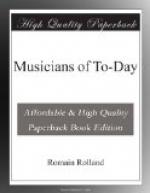“According to certain writers, who wish to reduce everything to a dead level and deduce all things from a single cause, Cesar Franck was a mystic whose true domain was religious music. Nothing could be wider of the mark. The public is given to generalisations, and is too easily gulled. They will judge a composer on a single work, or a group of works, and class him once and for all.... In reality, my father was a man of all-round accomplishments. As a finished musician, he was master of every form of composition. He wrote both religious and secular music—melodies, dances, pastorales, oratorios, symphonic poems, symphonies, sonatas, trios, and operas. He did not confine his attention to any particular kind of work to the exclusion of other kinds; he was able to express himself in any way he chose."[226]
But as what was really religious in him found itself in agreement with a current of thought that was rather powerful at that time, it was inevitable that this one side of his genius should be first brought to light, and that religious music should be the first to benefit by his work. And also one of the early manifestos[227] of the Schola Cantorum dealt with the reform of sacred music by carrying it back to great ancient models; and its first decision was as follows: “Gregorian chant shall rest for all time the fountain-head and the base of the Church’s music, and shall constitute the only model by which it may be truly judged."[228]
[Footnote 225: See the Essay on Vincent d’Indy.]
[Footnote 226: Revue d’histoire et de critique musicale, August-September, 1901.]
[Footnote 227: “The Schola Cantorum aims at creating a modern music truly worthy of the Church” (First number of the Tribune de Saint-Gervais, the monthly bulletin of the Schola Cantorum, January, 1895).]
[Footnote 228: The Schola had in mind here the vigorous work of the French Benedictines, which had been done in silence for the past fifty years; it was thinking, too, of the restoration of the Gregorian chant during 1850 and 1860 by Dom Gueranger, the first abbot of Solesmes, a work continued by Dom Jausions and Dom Pothier, the abbot of Saint-Wandrille, who published in 1883 the Melodies Gregoriennes, the Liber Gradualis, and the Liber Antiphonarius. This work was finally brought to a happy conclusion by Dom Schmitt, and Dom Mocqucreau, the prior of Solesmes, who in 1889 began his monumental work, the Paleo-graphie Musicals, of which nine volumes had appeared in 1906. This great Benedictine school is an honour to France by the scientific work it has lately done in music. The school is at present exiled from France.]
They added to this, however, music a la Palestrina, and any music that conformed to its principles or was inspired by its example. Such archaic ideas would certainly never create a new kind of religious music, but at least they have helped to restore the old art; and they received their official consecration in the famous letter written by Pope Pius X on the Re-form of Sacred Music.




